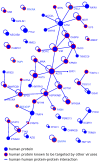Flavivirus NS3 and NS5 proteins interaction network: a high-throughput yeast two-hybrid screen
- PMID: 22014111
- PMCID: PMC3215679
- DOI: 10.1186/1471-2180-11-234
Flavivirus NS3 and NS5 proteins interaction network: a high-throughput yeast two-hybrid screen
Abstract
Background: The genus Flavivirus encompasses more than 50 distinct species of arthropod-borne viruses, including several major human pathogens, such as West Nile virus, yellow fever virus, Japanese encephalitis virus and the four serotypes of dengue viruses (DENV type 1-4). Each year, flaviviruses cause more than 100 million infections worldwide, some of which lead to life-threatening conditions such as encephalitis or haemorrhagic fever. Among the viral proteins, NS3 and NS5 proteins constitute the major enzymatic components of the viral replication complex and are essential to the flavivirus life cycle.
Results: We report here the results of a high-throughput yeast two-hybrid screen to identify the interactions between human host proteins and the flavivirus NS3 and NS5 proteins. Using our screen results and literature curation, we performed a global analysis of the NS3 and NS5 cellular targets based on functional annotation with the Gene Ontology features. We finally created the first flavivirus NS3 and NS5 proteins interaction network and analysed the topological features of this network. Our proteome mapping screen identified 108 human proteins interacting with NS3 or NS5 proteins or both. The global analysis of the cellular targets revealed the enrichment of host proteins involved in RNA binding, transcription regulation, vesicular transport or innate immune response regulation.
Conclusions: We proposed that the selective disruption of these newly identified host/virus interactions could represent a novel and attractive therapeutic strategy in treating flavivirus infections. Our virus-host interaction map provides a basis to unravel fundamental processes about flavivirus subversion of the host replication machinery and/or immune defence strategy.
Figures


Similar articles
-
Viperin Restricts Zika Virus and Tick-Borne Encephalitis Virus Replication by Targeting NS3 for Proteasomal Degradation.J Virol. 2018 Mar 14;92(7):e02054-17. doi: 10.1128/JVI.02054-17. Print 2018 Apr 1. J Virol. 2018. PMID: 29321318 Free PMC article.
-
Hsp40 Protein DNAJB6 Interacts with Viral NS3 and Inhibits the Replication of the Japanese Encephalitis Virus.Int J Mol Sci. 2019 Nov 14;20(22):5719. doi: 10.3390/ijms20225719. Int J Mol Sci. 2019. PMID: 31739611 Free PMC article.
-
Small-Molecule Inhibitor of Flaviviral NS3-NS5 Interaction with Broad-Spectrum Activity and Efficacy In Vivo.mBio. 2023 Feb 28;14(1):e0309722. doi: 10.1128/mbio.03097-22. Epub 2023 Jan 9. mBio. 2023. PMID: 36622141 Free PMC article.
-
Potential Role of Flavivirus NS2B-NS3 Proteases in Viral Pathogenesis and Anti-flavivirus Drug Discovery Employing Animal Cells and Models: A Review.Viruses. 2021 Dec 28;14(1):44. doi: 10.3390/v14010044. Viruses. 2021. PMID: 35062249 Free PMC article. Review.
-
The Many Faces of the Flavivirus NS5 Protein in Antagonism of Type I Interferon Signaling.J Virol. 2017 Jan 18;91(3):e01970-16. doi: 10.1128/JVI.01970-16. Print 2017 Feb 1. J Virol. 2017. PMID: 27881649 Free PMC article. Review.
Cited by
-
Host cell transcriptome profile during wild-type and attenuated dengue virus infection.PLoS Negl Trop Dis. 2013;7(3):e2107. doi: 10.1371/journal.pntd.0002107. Epub 2013 Mar 14. PLoS Negl Trop Dis. 2013. PMID: 23516652 Free PMC article.
-
A database of human genes and a gene network involved in response to tick-borne encephalitis virus infection.BMC Evol Biol. 2017 Dec 28;17(Suppl 2):259. doi: 10.1186/s12862-017-1107-8. BMC Evol Biol. 2017. PMID: 29297316 Free PMC article.
-
Role of RNA-binding proteins during the late stages of Flavivirus replication cycle.Virol J. 2020 Apr 25;17(1):60. doi: 10.1186/s12985-020-01329-7. Virol J. 2020. PMID: 32334603 Free PMC article. Review.
-
Targeting host factors to treat West Nile and dengue viral infections.Viruses. 2014 Feb 10;6(2):683-708. doi: 10.3390/v6020683. Viruses. 2014. PMID: 24517970 Free PMC article. Review.
-
Cytoarchitecture of ex vivo midgut cultures of unfed Ixodes scapularis infected with a tick-borne flavivirus.Ticks Tick Borne Dis. 2024 Mar;15(2):102301. doi: 10.1016/j.ttbdis.2023.102301. Epub 2023 Dec 21. Ticks Tick Borne Dis. 2024. PMID: 38134511 Free PMC article.
References
-
- Mackenzie JS, Gubler DJ, Petersen LR. Emerging flaviviruses: the spread and resurgence of Japanese encephalitis, West Nile and dengue viruses. Nat Med. 2004;10(12 Suppl):S98–109. - PubMed
-
- C M, Fauquet MAM, Maniloff J, Desselberger U, Ball LA. Virus Taxonomy: VIIIth Report of the International Committee on Taxonomy of Viruses. 2005.
-
- Melian EB, Hinzman E, Nagasaki T, Firth AE, Wills NM, Nouwens AS, Blitvich BJ, Leung J, Funk A, Atkins JF. et al.NS1' of flaviviruses in the Japanese encephalitis virus serogroup is a product of ribosomal frameshifting and plays a role in viral neuroinvasiveness. J Virol. 2010;84(3):1641–1647. doi: 10.1128/JVI.01979-09. - DOI - PMC - PubMed
MeSH terms
Substances
LinkOut - more resources
Full Text Sources
Other Literature Sources
Molecular Biology Databases
Research Materials

